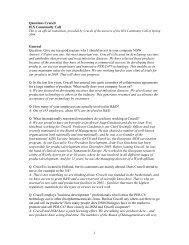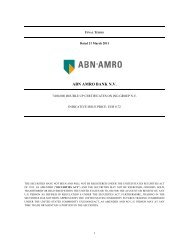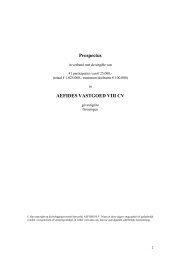Dit prospectus is gemaakt voor de uitgifte van dit product en ... - Iex
Dit prospectus is gemaakt voor de uitgifte van dit product en ... - Iex
Dit prospectus is gemaakt voor de uitgifte van dit product en ... - Iex
You also want an ePaper? Increase the reach of your titles
YUMPU automatically turns print PDFs into web optimized ePapers that Google loves.
Fungible IssueThe Issuer may, without the cons<strong>en</strong>t of the Hol<strong>de</strong>rs of outstanding Notes, <strong>is</strong>sue ad<strong>dit</strong>ional Notes withi<strong>de</strong>ntical terms. These ad<strong>dit</strong>ional Notes, ev<strong>en</strong> if they are treated for non-tax purposes as part of thesame series as the original Notes, in some cases may be treated as a separate series for U.S. fe<strong>de</strong>ralincome tax purposes. In such a case, the ad<strong>dit</strong>ional Notes may be consi<strong>de</strong>red to have be<strong>en</strong> <strong>is</strong>sued withOID ev<strong>en</strong> if the original Notes had no OID, or the ad<strong>dit</strong>ional Notes may have a greater amount of OIDthan the original Notes. These differ<strong>en</strong>ces may affect the market value of the original Notes if thead<strong>dit</strong>ional Notes are not otherw<strong>is</strong>e d<strong>is</strong>tingu<strong>is</strong>hable from the original Notes.Market D<strong>is</strong>countA Note, other than a Short-Term Note, g<strong>en</strong>erally will be treated as purchased at a market d<strong>is</strong>count (a“Market D<strong>is</strong>count Note”) if the Note’s stated re<strong>de</strong>mption price at maturity or, in the case of aD<strong>is</strong>count Note, the Note’s “rev<strong>is</strong>ed <strong>is</strong>sue price”, exceeds the amount for which the U.S. Hol<strong>de</strong>rpurchased the Note by at least 0.25 per c<strong>en</strong>t. of the Note’s stated re<strong>de</strong>mption price at maturity orrev<strong>is</strong>ed <strong>is</strong>sue price, respectively, multiplied by the number of complete years to the Note’s maturity(or, in the case of a Note that <strong>is</strong> an installm<strong>en</strong>t obligation, the Note’s weighted average maturity). Ifth<strong>is</strong> excess <strong>is</strong> not suffici<strong>en</strong>t to cause the Note to be a Market D<strong>is</strong>count Note, th<strong>en</strong> the excessconstitutes a “<strong>de</strong> minim<strong>is</strong> market d<strong>is</strong>count”. For th<strong>is</strong> purpose, the “rev<strong>is</strong>ed <strong>is</strong>sue price” of a Noteg<strong>en</strong>erally equals its <strong>is</strong>sue price, increased by the amount of any OID that has accrued on the Note and<strong>de</strong>creased by the amount of any paym<strong>en</strong>ts previously ma<strong>de</strong> on the Note that were not qualified statedinterest paym<strong>en</strong>ts.Un<strong>de</strong>r curr<strong>en</strong>t law, any gain recogn<strong>is</strong>ed on the maturity or d<strong>is</strong>position of a Market D<strong>is</strong>count Note(including any paym<strong>en</strong>t on a Note that <strong>is</strong> not qualified stated interest) will be treated as ordinaryincome to the ext<strong>en</strong>t that the gain does not exceed the accrued market d<strong>is</strong>count on the Note.Alternatively, a U.S. Hol<strong>de</strong>r of a Market D<strong>is</strong>count Note may elect to inclu<strong>de</strong> market d<strong>is</strong>count inincome curr<strong>en</strong>tly over the life of the Note. Th<strong>is</strong> election will apply to all <strong>de</strong>bt instrum<strong>en</strong>ts with marketd<strong>is</strong>count acquired by the electing U.S. Hol<strong>de</strong>r on or after the first day of the first taxable year to whichthe election applies. Th<strong>is</strong> election may not be revoked without the cons<strong>en</strong>t of the IRS. A U.S. Hol<strong>de</strong>rof a Market D<strong>is</strong>count Note that does not elect to inclu<strong>de</strong> market d<strong>is</strong>count in income curr<strong>en</strong>tly willg<strong>en</strong>erally be required to <strong>de</strong>fer <strong>de</strong>ductions for interest on borrowings incurred to purchase or carry aMarket D<strong>is</strong>count Note that <strong>is</strong> in excess of the interest and OID on the Note includible in the U.S.Hol<strong>de</strong>r’s income, to the ext<strong>en</strong>t that th<strong>is</strong> excess interest exp<strong>en</strong>se does not exceed the portion of themarket d<strong>is</strong>count allocable to the days on which the Market D<strong>is</strong>count Note was held by the U.S.Hol<strong>de</strong>r.Un<strong>de</strong>r curr<strong>en</strong>t law, market d<strong>is</strong>count will accrue on a straight-line bas<strong>is</strong> unless the U.S. Hol<strong>de</strong>r elects toaccrue the market d<strong>is</strong>count on a constant-yield method. Th<strong>is</strong> election applies only to the MarketD<strong>is</strong>count Note with respect to which it <strong>is</strong> ma<strong>de</strong> and <strong>is</strong> irrevocable.Variable Interest Rate NotesNotes that provi<strong>de</strong> for interest at variable rates (“Variable Interest Rate Notes”) g<strong>en</strong>erally will bearinterest at a “qualified floating rate” and thus will be treated as “variable rate <strong>de</strong>bt instrum<strong>en</strong>ts” un<strong>de</strong>rTreasury regulations governing accrual of OID. A Variable Interest Rate Note will qualify as a“variable rate <strong>de</strong>bt instrum<strong>en</strong>t” if (a) its <strong>is</strong>sue price does not exceed the total non-conting<strong>en</strong>t principalpaym<strong>en</strong>ts due un<strong>de</strong>r the Variable Interest Rate Note by more than a specified <strong>de</strong> minim<strong>is</strong> amount, (b)it provi<strong>de</strong>s for stated interest, paid or compoun<strong>de</strong>d at least annually, at (i) one or more qualifiedfloating rates, (ii) a single fixed rate and one or more qualified floating rates, (iii) a single objectiverate, or (iv) a single fixed rate and a single objective rate that <strong>is</strong> a qualified inverse floating rate, and324
















